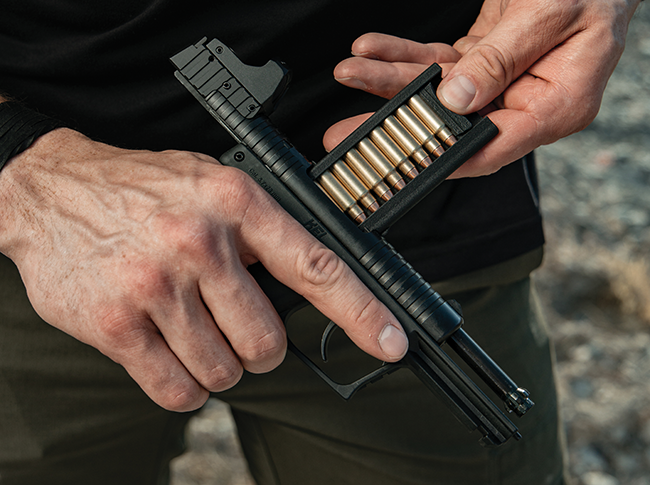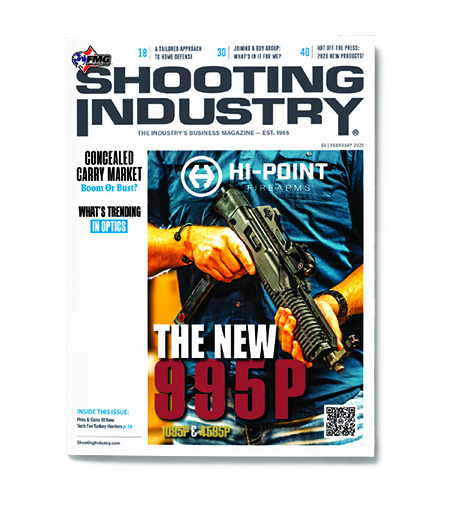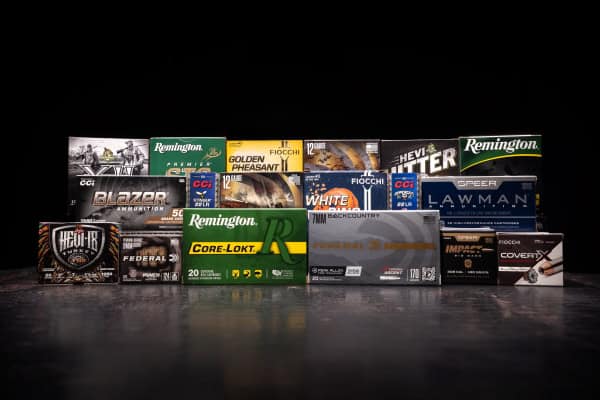Concealed Carry Market: Boom Or Bust?
A big part of owning a gun store is selling. But to thrive, you need to do much more than just stock the latest and greatest rifles, shotguns and pistols.
One of your most important profit centers is the wide range of extras that go with those guns. Whether it’s spare magazines, optics, cleaning kits, holsters or storage devices, these accessories offer a chance to make up for the tight margins on guns.
“We’ve got to keep our prices low enough to compete with Cabela’s and Bass Pro and everybody else,” noted Jacquelyn Clark, owner of Bristlecone Shooting, Training & Retail Center in Lakewood, Colo. “If we only sold firearms, we wouldn’t be in business for very long.”
Naturally, some guns lend themselves to accessory sales better than others. This brings us to the concealed carry segment, which, for many stores is one of the strongest drivers of customer traffic.
Heading into a new year with a new U.S. president and a Republican-controlled Congress, there’s considerable uncertainty in the overall firearms market. There’s even talk of a potential “Trump slump” — with no external pressures sending customers into stores.
But is there room for some optimism, particularly in concealed carry sales? This snapshot was taken in late December, allowing some time for election results to settle in the minds of customers.
So far, so good, according to Henry Parro, owner of Parro’s Gun Shop in Waterbury, Vt.
“We had a record month in November,” Parro explained. “Looking at the reports, there’s a high number of concealed carry firearms rolling out of here. And we had a high number of coaching and training sessions to go along with it.”
It’s often difficult to pinpoint exactly what’s bringing in customers during a given month. But he sees some surprising connections to the November election, with new faces walking showing up in the store.
“For whatever reason, they felt a little threatened about the outcome of the election,” Parro stated. “We’re getting a ton of first-time shooters, which is typically unheard of when a Republican is elected. Gun sales are usually pretty stagnant.”
There’s similar strength in sales at Ace Sporting Goods in Washington, Pa., noted owner Ben Romanoff.
“The concealed carry market has picked up,” he said. “It’s been kind of a pleasant surprise from what we were seeing.”
As has been the case for some time, 9mm handguns remain the top sellers for all three of these stores. The most popular models include the GLOCK 43X, Springfield Armory Hellcat and SIG SAUER’s P365 line.
The favored caliber’s smaller cousin, however, is also showing a bit of life. Romanoff’s shop has witnessed an uptick in .380 over the past couple of years, thanks to the newer pocketable guns like the Ruger LCP MAX and, more recently, the Smith & Wesson BODYGUARD 2.0 — the current best-selling gun in the store.
“You get 12 rounds of .380 in your pocket, without stretching your pocket and leaving a print,” Romanoff said.
Those features — size and capacity — are among the most important for concealed carry shoppers, noted Clark in Colorado. But so too is ease of use: “Especially for older customers, they want to make sure they can operate the firearm and rack the slide.”
Extras: Red Dots Here To Stay
Every gun in your shop has some accessory able to be sold with it. But CCW guns have an advantage over most of them.
Consider someone shopping for a range gun. They may plan to shoot it soon, but there’s no particular rush to buy things they can easily add on later. There’s a different dynamic at play for CCW shoppers, suggests Romanoff, in Pennsylvania.
“When someone makes the decision to upgrade or buy a new concealed carry pistol, they’re going to get the whole thing ‘right now,’” he said. “They want to take the thing home, clean it, load it and put it on their belt or in their pocket.”
This means more opportunities to sell holsters, magazines, cleaning kits, storage safes, self-defense ammo and, of course, red dots.
Long gone are the days when dots and optic cuts were more of a trending curiosity aimed at older shooters with declining vision. Today, even if customers aren’t buying dots right away, they still want guns designed to accept one.
“Everything now is optic ready,” Romanoff noted. “It’s not a trend anymore. It’s here to stay.”
At Parro’s in Vermont, the subject often comes up during discussions to evaluate customer needs. The shop has demonstration guns set up with dots to help customers better understand the potential advantages.
“Once that red dot pops into play, they just get a smile on their face,” Parro exclaimed.
Like the other shops, Parro’s does particularly well with the less-expensive offerings from Vortex and Holosun. On the pricier side, popular makers are Trijicon and Aimpoint.
Not every customer is going to buy an optic right away. They’re more likely to add a holster, spare magazine and self-defense ammo. To help with the latter, staffers explain the advantages of buying range ammo for practice and a break-in period, but also the need for self-defense ammo — including some to test in the gun.
“You should pop off some rounds to see the difference in the recoil and to see if there’s a difference in the point of impact,” Parro stated.
Holster popularity varies widely by store, with brands including Safariland (particularly for specialty items), Bravo Concealment and Tagua Gunleather. And while more holsters are being made to accommodate optics, it’s more of a challenge when someone wants to add a weapon light.
“It’s really difficult to find a holster that’s going to fit your light,” Romanoff said. “There are a lot of guns and a lot of lights. It’s hard to stock all of those.”
Another area seeing some growth is secure storage. It’s particularly true in Colorado, where state law requires guns kept in cars to be locked up.
Bristlecone Shooting carries a wide range of these, but the most popular are made by Vaultek, with features including biometric and Bluetooth technologies.
“They have ones that fit in your car. They have ones able to fit in your bookcase,” Clark shared. “They have ones with the look of an alarm clock, but that store a firearm.”
Training
Not all offered accessories need shelf space. (At least, not if you think of personal training and classes as an extra you can sell.) Unfortunately, too many gun stores aren’t offering any type of training for customers.
As detailed in a recent Shooting Industry issue, nearly half of the respondents surveyed in the 2024 NSSF First-Time Gun Buyers report weren’t offered training when they purchased guns.
Of course, it’s much easier for shops with a range and classroom space to provide this type of service. Even if you don’t have these things, there may be opportunities to be creative, including partnerships with local gun clubs or, at least, vetting local trainers you can recommend to customers.
Tapping into this demand can provide a solid boost to your bottom line, while also helping to foster better educated and more proficient gun owners.
In Colorado, Bristlecone Shooting offers a wide range of courses, focusing on handguns, shotguns and rifles. Along with tactical classes, they offer a couple of different versions of concealed carry training — one geared toward beginners and another for more experienced shooters. Demand has been strong, with class attendance up 20% in 2024 compared to the previous year.
For Clark, this educational component is a key part of the business.
“If somebody’s buying a gun for personal or home defense, it’s a tool. It doesn’t do them any good if they don’t understand how to use it,” she asserted.
Parro, in Vermont, has a similar take. His store has a separate training division and recently partnered with a training group dominated by instructors with law enforcement and military backgrounds. Among the broad range of offerings are concealed carry classes — including an option for women only.
Courses are promoted through in-store marketing. And they’re developing a website that will allow customers to sign up and pay online. But the key to connecting with customers is the sales staff.
Through conversations and interactions (including watching customers’ gun-handling skills) staffers evaluate which customers might benefit the most from training. In addition to the established classes, the store offers one-hour coaching sessions ($99) covering things like firearm basics and how to choose a gun.
“When we see someone in the store who is maybe struggling trying to find their ‘right’ first firearm, we talk about training and coaching,” Parro reasoned. “We’re fortunate we have enough employees on the range who are instructors. Sometimes we can do it right on the spot.”
“Opportunity” In The Forecast
Guessing what’s going to happen next in any business is always difficult. It’s even more challenging for an industry that has experienced severe and unexpected demand shifts.
Even now, there are some elements of fear — though nothing like the COVID-era panic — filtering into stores. Many gun enthusiasts may be happy with recent political events, but it’s hard to deny the nation is feeling stressed.
“I think after this most recent election, for me personally, some tension was lifted,” said Romanoff, in Pennsylvania. “But on the other side, probably people don’t feel the same.”
This is pushing some new gun buyers into stores — a dynamic similar, although to a much lesser degree, to what we saw around the COVID pandemic. Again, it brings the opportunity to convert first-timers into second- and third-timers.
“My hope is we get a certain percentage of these new buyers on our side,” Parro declared. “Maybe we can get them to see our point of view — guns themselves are not bad.”
But if fear and anxiety don’t drive the market, is there anything else that can? We already have optic cuts and pocketable guns with substantial increases in capacity. Is there some other innovation capable of pushing more customers to seek out new carry guns?
“It’s a good question, and I don’t really have an answer,” observed Clark, in Colorado. “I don’t feel like the market is saturated. We continue to grow, with the number of students we’re putting through those classes, and the number of firearms in this category we sell, as well as the accessories. I don’t know what the next big thing is going to be.”
It’s anyone’s guess at this point, but there are signs a second “Trump Slump” may not be as pronounced as previously feared. Agreed/disagree? We invite you to weigh in anytime: editor@shootingindustry.com.






